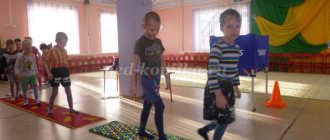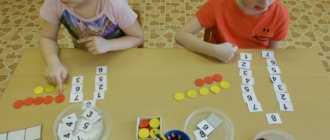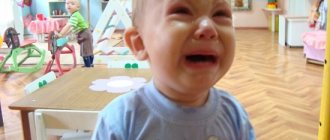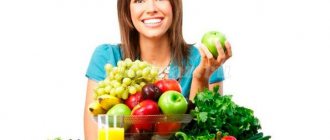Watching sparrows in winter with older children in kindergarten
Observations with older children during walks in winter
Observation of sparrows
Purpose: to consolidate knowledge about urban birds; clarify knowledge about the appearance, habits, and habitat of sparrows. Progress of observation
Sparrows live well, If the house has a warm roof and there is a feeder nearby, Where food is always poured in for them.
-What kind of bird is this? - What color is the plumage? —What do sparrows eat? — How can people help sparrows during the cold season? Proverbs: Where there is millet, there is a sparrow; And a sparrow does not live without people. Signs: If you see sparrows building their nests, the weather will probably be good; If a sparrow flies low above the ground and shouts something in its bird's ear, it means rain. P/i “Sparrows and a cat” Purpose: to teach children to “fly” only at a signal, to move within the area, to jump on two legs.
Observing weather changes Purpose: to learn to name seasonal changes in nature in winter. Progress of observation
You, frost, frost, do not show us your nose.
Go home quickly, take the cold with you. — Is it warm or cold outside? — Why do people dress warmly and walk quickly down the street? Proverbs: The frost is not great, but it does not tell you to stand; In the cold, a kind owner will not even throw the dog out of the gate; Take care of your nose in the extreme cold. Signs: The stars shine very much - it means frost; Crows croak in a flock - it means frost. P/i “Frost is a red nose” Goal: to clearly pronounce the text in the game; to follow the rules of the game.
Observing a crow Purpose: to practice recognizing birds by description; consolidate knowledge about the habits of crows; cultivate a kind attitude towards birds. Progress of observation
On a birch tree near the house a raven was building a nest.
Guards day and night, The crow wants to become a mother. -What does a crow look like? -What does this bird eat? -Where does the crow live? — Does this bird fly away to warmer climes? Proverbs: A crow can be recognized even in peacock feathers; Without a tail, a crow is not red. Signs: A crow croaks in winter - a blizzard; Crows crow - foretells bad weather. P/i "Crows" Purpose: to teach to run in different directions; act on command.
Observing the sun Goal: to continue to expand knowledge about the sun in winter; develop interest in inanimate objects of nature. Progress of observation
The cloud hides behind the forest, The sun looks from the sky.
And so pure, kind, radiant. -What does the sun look like? -What is the sun like today? Proverbs: The red sun in the white world warms the black earth; Summer is bad when there is no sun. Signs: If in winter the sunset is purple, it means a lot of snow or a blizzard. P/i “Sun” Goal: to encourage children to be physically active; perform movements in accordance with the text.
Observing the wind Purpose: to develop the ability to determine the direction of the wind. Progress of observation
I will draw a quiet, gentle wind, I will draw a thunderous and snowy one, And one that plays with the grass, And one that raises waves.
— Is the wind blowing? — How can you tell if the wind is blowing? — Is it cold or warm? - Which direction does the wind blow? Proverbs: You can’t keep up with the wind in the field; The wind flies without wings. Signs: If there is wind for three days in a row, then the whole month will be windy. The clouds go against the wind - towards the snow. P/i “Wind, breeze” Goal: development of agility; ability to run fast.
Watching a Magpie Goal: to continue to generate interest in the world around us; cultivate a caring attitude towards birds; to form knowledge about the appearance of a magpie. Observation progress
Magpies on the fence are chattering patter.
They tell the news - they collected so much in a day! -What does a magpie look like? -What does this bird eat? — How does a magpie take care of its chicks? Proverbs: The magpie brought it on its tail; The magpie knows where to spend the winter. Signs: A magpie climbs under the eaves - towards the blizzard. P/i “Birds in the Nest” Purpose: actions on a signal; create positive emotions in children.
Observation of birch and spruce Goal: to continue to cultivate a caring attitude towards nature; identify the tree by description; determine the characteristic features of deciduous and coniferous trees. Progress of observation
White birch tree Under my window Covered with snow, Like silver.
- What trees do you know? — What is the difference between coniferous and deciduous trees? — How do trees feel in winter? — Why do trees need snow? Proverbs: As are the birches, so are the shoots; Over the sea - up to fir cones. Signs: The earrings of a birch tree burst - it’s time to sow bread. P/i “Make a wish on a tree” Purpose: to consolidate the names of trees; develop attention and dexterity.
Observing bird tracks in the snow Purpose: to expand knowledge about wintering birds; recognize bird tracks; cultivate observation skills. Progress of observation
Who was walking in the snow?
Guess the trail! Every snow bird's trail hides a secret. —Have you noticed that there are a lot of bird tracks in the snow? - Who do you think left small footprints in the snow? - Who owns the big footprints? Proverbs: The bird is not great, but its claw is sharp; Every bird praises its nest. Signs: A titmouse knocks on the window - there will be news; A stork makes a nest on the chimney of a house - happiness awaits the owner. P/i "Crow - Tit" Purpose: perform actions on command; cultivate friendly relationships.
Observing snow Goal: to continue to form children’s ideas about the properties of snow. Progress of observation:
Winter snows in from morning until dark.
Snowflakes curl and swirl around our window. — What color is the snow? - Why does snow melt on your palm? — What does snow feel like? Proverbs: Snow is cold, but it protects you from the cold; The snow is deep - the bread is good. Signs: Large frost, mounds of snow, deeply frozen ground - for the harvest; If in January there are frequent snowfalls and blizzards, then in July there is frequent rain. P/i “The snow is spinning” Purpose: to learn to correlate one’s own actions with the actions of other participants; develop motor activity.
Observing snowflakes Goal: to continue to consolidate knowledge about the properties of snowflakes. Progress of observation:
Downy snowflakes, cheerful and alive!
You spin and flicker in the silence of the forest And you cover the earth with shining silver. — What color are the snowflakes? — How many rays does a snowflake have? Proverbs: In a warm winter coat, even frost is a joke; Blizzards and blizzards arrived by February. Signs: If the snow falls on the damp ground and does not melt, then in the spring snowdrops will bloom early and amicably; Frost falls at night, but there will be no snow during the day. P/i “Snowflakes and the Wind” Goal: improving the ability to act on a signal.
Observing bullfinches Goal: expand ideas about the appearance and habits of bullfinches. Progress of observation:
A flock of red-breasted birds sits in the snow, shining.
Let's throw the crumbs as soon as possible for the handsome bullfinches. - What does a bullfinch look like? — What do bullfinches eat? Proverbs: The bullfinch will fly in and visit you about winter. Signs: A bullfinch chirps under the window - a thaw; The bullfinch whistles - winter is coming. P/i “Bullfinches on rowan branches” Goal: development of motor activity; ability to run at a signal.
Observation of the titmouse Purpose: to expand ideas about the appearance of the titmouse, its habitat; take care of wintering birds. Progress of observation:
The cheerful titmouse is not afraid of Morozov, even at minus twenty-five. He loves to sing songs!
-What does a titmouse look like? -What does she eat? —Where does he spend the winter? Proverbs: A titmouse is not big, but it is also a bird; A bird in the hands is better than a nightingale in the forest. Signs: A titmouse sits on your hand - your cherished wish will come true. P/i “Nimble Titmouse” Purpose: to perform actions on a signal.
Observation of mountain ash Purpose: to continue monitoring the mountain ash in winter; consolidate knowledge about shrubs. Progress of observation:
They hang in clusters, Their outfit is beautiful.
Gather a string of berries for your soul, Beads made from rowan are very good! — What kind of shrubs do you know? — What birds eat rowan berries? Proverbs: Let's go out into the valley, sit under the mountain ash - it blooms well. Signs: There are a lot of berries on the rowan tree - it means frost. Late flowering of rowan - for a long autumn. P/i “Birds on the Rowan Tree” Goal: to develop reaction speed. Observing the sky Goal: to continue to form an understanding of the sky. Progress of observation: The sad sky in the morning frowns like a black cloud, But the children are not afraid, They run into the street again. —Are clouds always the same? -What color is the sky? — Determine where the clouds are floating? Proverbs: Everything is possible, you can’t just climb into the sky; No matter how hard you walk, you won’t be able to get into heaven. Signs: Blue evening clouds - a change in weather; The sky is blue - for warmth, light - for frost, dark - for a snowstorm. P/i “Cloud” Purpose: to teach how to run in a limited area.
We recommend watching:
Summary of a winter walk - observation in kindergarten A winter walk with children A winter walk in a preparatory group for children with hearing impairment “Zimushki” dance of girls in the senior group of preschool age
Similar articles:
Summary of GCD in the second junior group of kindergarten
Summary of an integrated lesson in the senior group of kindergarten on the topic “Winter Riddles”
Summary of a lesson on cognition in the senior group on the topic: Sorceress - winter
Walking in the senior group. Card file with goals for December
Walking in the senior group. Card file with goals for January
Walk summary middle group “Observation of sparrows”
Summary of a walk
observing wildlife phenomena.
Watching sparrows. Middle group. Target
– teach to see changes in the behavior of sparrows with the arrival of spring; cultivate an interest in bird watching and a caring attitude towards them.
In a ditch with melt water
A sparrow splashes.
Like a carefree boy
He wants to dive headlong...
Perky, dashing sparrow -
I'm afraid of scaring him away.
The sun is barely warming the guys, the sparrows are perking up and gathering in noisy flocks. Notice the sparrow's animated behavior. Have you noticed what changes have occurred in the life of the bird with the arrival of spring? (The sparrows rejoice at her and chirp provocatively: chik-tweet, chik-tweet.)
Let's remember what the sparrow ate in winter? (Grains, crumbs.) And in summer and autumn? (They peck at grains and plant seeds.) And in the spring? (Sparrows like to eat midges, mosquitoes, caterpillars, aphids.) Guys, do you already know that sparrows build a nest in the spring? Let's look for nests on the territory of the kindergarten. Building a nest is not easy. What do sparrows build their nests from? (Made from feathers, dry blades of grass, pieces of cotton wool.) Why do sparrows need nests? (Eggs are incubated in nests.) Yes, a pair of sparrows builds a nest together, and then they take turns incubating the eggs. After two weeks, small chicks appear in the nest. While the chicks are small, who feeds them? (Parents.) What do parents feed their babies? (By midges, mosquitoes and other insects.) Sparrows grow quickly, and within ten days their parents begin to teach them all the intricacies of sparrow life. Over the summer, one or two more new generations appear in the nest. Before the onset of cold weather, they also need to be raised and trained in a bird school.
Labor activity:
Guys, did you notice that we took a bag of cereal and bread crumbs with us for a walk. Why do you think the children's answers are correct - to feed our defenseless sparrows.
In order to feed them, we need to pour food into the feeder, let’s do that now and feed the birds. Goal: to cultivate a desire to take care of defenseless birds, to cultivate a sense of responsibility, a sense of compassion for wintering birds.
Outdoor games
1. “Run to the flag.”
Goal: to teach to perform actions strictly according to the teacher’s signal. To develop children's attention and ability to distinguish colors. Practice running and walking.
2. “The Mother Hen and the Chicks”
— To develop in children the ability to perform movements on a signal, to practice running in different directions and crawling.
Individual work.
Development of movements
Walking on a log straight and sideways, maintaining balance.
Independent play activity.
Free games with external materials (spatulas, buckets, molds, balls)





